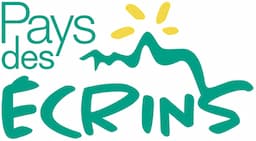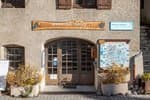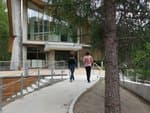RANDOLAND: Pelvoux
With your clue sheets and pens at the ready, this Randoland circuit through the hamlets of Pelvoux introduces you to the authentic local heritage and offers plenty of opportunities to admire Mont Pelvoux!
Description
The walk starts at the Pelvoux-Vallouise ski resort.
- Opposite the chairlift chalet, go between the swimming pool and the Freissinet ski lift. When you come to the car park, carry straight on.. Carry on along the paved track opposite. Cross over a bridge and carry straight on. 50 metres after the campsite sanitary facilities, stop at the footbridge to enjoy the view over the Gyr. Go back onto the paved campsite track until you come to a sign reading “Vallée de Vallouise”. Cross the bridge, which brings you to the road. Cross at the pedestrian crossing.
- Go 20 metres to your right to discover the chapel. Retrace your steps back to the pedestrian crossing, go up the street on the right and stop at the wash house. Carry straight on uphill until you come to the hike post entitled “Le Riou” and take the path leading towards “Pelvoux - Saint Antoine” immediately on the right.
- When you come to the road, go downhill to the right. Just after the holiday home “Les Balmettes”, do downhill to the right to discover the church. Retrace your steps back up to the crossroads and continue right. Go past the cemetery and, immediately after this, go uphill to the left. Then follow the path on the right signed ”Le Fangeas par le canal”. Go past the first canal lock. Follow the canal right until you come to a second lock.
- Turn down to the right through the trees to return to the road. Head for the chapel and its wash house on the left. Retrace your steps for a few metres and then cross at the bus stop to take the grass track between the fences. At the end, continue right and then cross the bridge on the left to complete the walk.
- Departure : Tourist information office ("Bureau d’Information Touristique"),Pelvoux-Vallouise resort
- Arrival : Tourist information office ("Bureau d’Information Touristique"),Pelvoux-Vallouise resort
- Towns crossed : Vallouise-Pelvoux
Altimetric profile
Recommandations
To download the Randoland clue sheets, visit the Office de Tourisme Intercommunal du Pays des Écrins website.
Check weather conditions before setting off.
Rescue services contact details: Secours Montagne (Mountain Rescue): +33 (0)4 92 22 22 22 or 112
Show consideration for the work of farmers, livestock keepers and owners
Close all gates behind you
Take your litter home
Do not take shortcuts across pastureland
Information desks
Place de l'Eglise, 05340 Vallouise
Vallouise Park house
, 05290 Vallouise
Information, documentation, models, exhibitions, screenings, product sales and works of the Park. Guided tours for school, reservation required. The new Park House opened in Vallouise since June 1, and offers visitors an interactive permanent exhibition inviting to explore the area and its heritage. A temporary exhibition space will allow a renewed offer. Finally, the device is completed by an audiovisual room to organize screenings and conferences Free admission. All animations of the Park are free unless otherwise stated.
Transport
Public transport >> www.pacamobilite.fr
Consider car-sharing >> www.blablacar.fr
For more information, ask at the Tourist Information Office nearest to the trail starting point.
Access and parking
12.5 km from L'Argentière-La Bessée, take the D994E.
Parking :
8 points of interest
 History
HistoryPelvoux
Pelvoux is made up of a succession of small hamlets: Le Poët, Le Sarret, Le Fangéas, Saint-Antoine, Les Claux, Chambran and Ailefroide. Until 1893, Pelvoux was actually called La Pisse, after the name of the L'Eychauda waterfall. Since this name attracted wide mockery, it was changed to Pelvoux. “Peuvo” and “pelva” mean very high mountain, a nod to Mont Pelvoux, one of the highest peaks within the municipality’s territory.
 History
HistoryThe ski resort of Pelvoux-Vallouise
In the winter, Pelvoux-Vallouise is a ski resort that is close to nature, with very good sun exposure and high quality snow. With 35 kilometres of marked pistes, off-piste skiing, cross-country skiing, a toboggan run, a children's snow club, snowshoe hiking, paragliding and more, Pelvoux is a family-oriented resort suitable for all levels of ability.
In the summer, a number of trails start from the various hamlets. You can also take part in mountain biking, enjoy a very fine via ferrata, go swimming... Water
WaterThe Gyr
Humans are decidedly bizarre animals: they build, knock down and start again. To protect the new infrastructures of Pelvoux, the Gyr was dammed. But, not able to flow as it did before, it deepened its bed, thus placing the foundations in danger of damage. And so works were carried out to widen its bed, allowing it to flow more naturally. This is also more favourable for biodiversity, as well as protecting the developed urban areas. Flora
FloraThe grey alder
In the valleys of the Alps and the Jura, the grey alder often grows in place of the black alder, present in many parts of France. Like its cousin, it grows on riversides and plays an important role in stabilising the banks. If it is cut down, its wood is bright orange in colour. But why cut it down? Vernacular heritage
Vernacular heritageThe minor heritage of Pelvoux
Every hamlet has its own chapel. In the territory of Pelvoux, Les Claux has the chapel of Sainte-Barbe with a restored sun dial dating from 1792. The seventeenth-century chapel of Saint-Pancrace is in Le Poët. In Le Sarret, you can admire the chapel of Saint-Joseph and the chapel of Notre-Dame des Sept Douleurs stands in Le Fangeas. Every hamlet has its own communal oven and water fountains as well. Finally, the church of Saint-Antoine is located in the hamlet of Saint-Antoine. It has a sun dial dating from 1810.
 Flora
FloraThe Zygaena transalpina
A nocturnal moth but also active during the day, the Zygaena transalpina, the transalpine burnet, has thick antennae and red spots on its black to bluish wings. They extract chemical compounds similar to cyanide (a potent poison) from the plants, which they can secrete from their mouthparts and joints when they feel threatened.
 Know-how
Know-howThe "coulage" laundry day
The dirtiest linen at the bottom and a large sheet last, which collected the wood ash. The «used» water was collected and reheated several times until the «washing powder» (potash from the ash) had achieved the required standard of cleanliness. Often, a few stems and roots of soapwort were added to give the water a soapy quality. The «coulage» sometimes took up the entire day and the house was filled with a pleasant smell! Finally, the laundry was wheeled on a barrow to the pond for rinsing. Small items were spread out on the blanched grass in the meadow.
 Vernacular heritage
Vernacular heritageThe ski resort of Pelvoux-Vallouise
The route first leads through the small ski resort of Pelvoux-Vallouise, built in 1982. Very family-focused, in winter it's the ideal place for young children to learn to ski, with small lifts lower down, while their big brothers and sisters can ski higher up.
Accessibility
Source

Report a problem or an error
If you have found an error on this page or if you have noticed any problems during your hike, please report them to us here:


